Related Research Articles
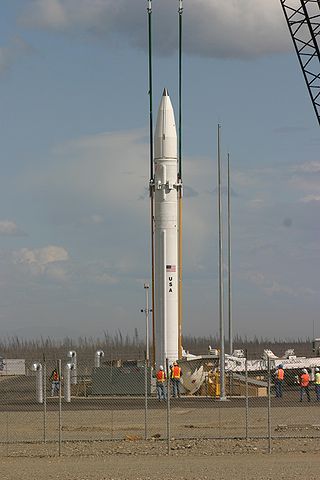
An anti-ballistic missile (ABM) is a surface-to-air missile designed to counter ballistic missiles. Ballistic missiles are used to deliver nuclear, chemical, biological, or conventional warheads in a ballistic flight trajectory. The term "anti-ballistic missile" is a generic term conveying a system designed to intercept and destroy any type of ballistic threat; however, it is commonly used for systems specifically designed to counter intercontinental ballistic missiles (ICBMs).

The MIM-104 Patriot is a surface-to-air missile (SAM) system, the primary such system used by the United States Army and several allied states. It is manufactured by the U.S. defense contractor Raytheon and derives its name from the radar component of the weapon system. The AN/MPQ-53 at the heart of the system is known as the "Phased Array Tracking Radar to Intercept on Target," which is a backronym for "Patriot". In 1984, the Patriot system began to replace the Nike Hercules system as the U.S. Army's primary high to medium air defense (HIMAD) system and the MIM-23 Hawk system as the U.S. Army's medium tactical air defense system. In addition to these roles, Patriot has been given a function in the U.S. Army's anti-ballistic missile (ABM) system. As of 2016, the system is expected to stay fielded until at least 2040.

The Arleigh Burke class of guided-missile destroyers (DDGs) is a United States Navy class of destroyer centered around the Aegis Combat System and the SPY-1D multi-function passive electronically scanned array radar. The class is named for Admiral Arleigh Burke, an American destroyer officer in World War II and later Chief of Naval Operations. With an overall length of 505 to 509.5 feet, displacement ranging from 8,300 to 9,700 tons, and weaponry including over 90 missiles, the Arleigh Burke-class destroyers are larger and more heavily armed than many previous classes of guided-missile cruisers.
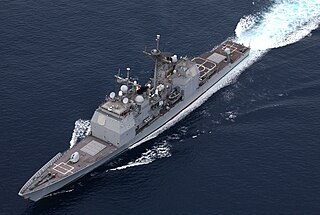
The Aegis Combat System is an American integrated naval weapons system, which uses computers and radars to track and guide weapons to destroy enemy targets. It was developed by the Missile and Surface Radar Division of RCA, and it is now produced by Lockheed Martin.

The Aegis ballistic missile defense system, also known as Sea-Based Midcourse, is a Missile Defense Agency program under the United States Department of Defense developed to provide missile defense against short and intermediate-range ballistic missiles. The program is part of the United States national missile defense strategy and European NATO missile defense system.

National missile defense (NMD) refers to the nationwide antimissile program the United States has had in development since the 1990s. After the renaming in 2002, the term now refers to the entire program, not just the ground-based interceptors and associated facilities.

Ground-Based Midcourse Defense (GMD) is the United States' anti-ballistic missile system for intercepting incoming warheads in space, during the midcourse phase of ballistic trajectory flight. It is a major component of the American missile defense strategy to counter ballistic missiles, including intercontinental ballistic missiles (ICBMs) carrying nuclear, chemical, biological or conventional warheads. The system is deployed in military bases in the states of Alaska and California; in 2018 comprising 44 interceptors and spanning 15 time zones with sensors on land, at sea, and in orbit. In 2019, a missile defense review requested that 20 additional ground-based interceptors be based in Alaska.

An active electronically scanned array (AESA) is a type of phased array antenna, which is a computer-controlled antenna array in which the beam of radio waves can be electronically steered to point in different directions without moving the antenna. In the AESA, each antenna element is connected to a small solid-state transmit/receive module (TRM) under the control of a computer, which performs the functions of a transmitter and/or receiver for the antenna. This contrasts with a passive electronically scanned array (PESA), in which all the antenna elements are connected to a single transmitter and/or receiver through phase shifters under the control of the computer. AESA's main use is in radar, and these are known as active phased array radar (APAR).
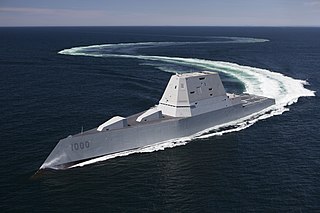
The Zumwalt-class destroyer is a class of three United States Navy guided-missile destroyers designed as multi-mission stealth ships with a focus on land attack. The class was designed with a primary role of naval gunfire support and secondary roles of surface warfare and anti-aircraft warfare. The class design emerged from the DD-21 "land attack destroyer" program as "DD(X)" and was intended to take the role of battleships in meeting a congressional mandate for naval fire support. The ship is designed around its two Advanced Gun Systems (AGS), turrets with 920 round magazines, and unique Long Range Land Attack Projectile (LRLAP) ammunition. LRLAP procurement was canceled, rendering the guns unusable, so the Navy re-purposed the ships for surface warfare. Starting in 2023, the Navy will remove the AGS from the ships and replace them with hypersonic missiles.

Terminal High Altitude Area Defense (THAAD), formerly Theater High Altitude Area Defense, is an American anti-ballistic missile defense system designed to shoot down short, medium, and intermediate-range ballistic missiles in their terminal phase by intercepting with a hit-to-kill approach. THAAD was developed after the experience of Iraq's Scud missile attacks during the Gulf War in 1991. The THAAD interceptor carries no warhead, instead relying on its kinetic energy of impact to destroy the incoming missile.

The Sejong the Great-class destroyers, also known as KDX-III, are three guided-missile destroyers of the Republic of Korea Navy (ROKN).

The RIM-161 Standard Missile 3 (SM-3) is a ship-based surface-to-air missile system used by the United States Navy to intercept short- and intermediate-range ballistic missiles as a part of Aegis Ballistic Missile Defense System. Although primarily designed as an anti-ballistic missile, the SM-3 has also been employed in an anti-satellite capacity against a satellite at the lower end of low Earth orbit. The SM-3 is primarily used and tested by the United States Navy and also operated by the Japan Maritime Self-Defense Force.

The RIM-174 Standard Extended Range Active Missile (ERAM), or Standard Missile 6 (SM-6), is a missile in current production for the United States Navy. It was designed for extended-range anti-air warfare (ER-AAW) purposes, providing capability against fixed and rotary-wing aircraft, unmanned aerial vehicles, anti-ship cruise missiles in flight, both over sea and land, and terminal ballistic missile defense. It can also be used as a high-speed anti-ship missile. The missile uses the airframe of the earlier SM-2ER Block IV (RIM-156A) missile, adding the active radar homing seeker from the AIM-120C AMRAAM in place of the semi-active seeker of the previous design. This will improve the capability of the Standard missile against highly agile targets and targets beyond the effective range of the launching vessels' target illumination radars. Initial operating capability was planned for 2013 and was achieved on 27 November 2013. The SM-6 is not meant to replace the SM-2 series of missiles but will serve alongside and provide extended range and increased firepower. It was approved for export in January 2017.

The AN/SPY-6 is an active electronically scanned array 3D radar under development for the United States Navy (USN). It will provide integrated air and missile defense for Flight III Arleigh Burke-class destroyers. Variants are under development for retrofitting Flight IIA Arleigh Burkes and for installation aboard Constellation-class frigates, Gerald R. Ford-class aircraft carriers, America-class amphibious assault ships, and San Antonio-class amphibious transport docks.

The AN/SPY-1 is a United States Navy 3D radar system manufactured by Lockheed Martin. The array is a passive electronically scanned system and a key component of the Aegis Combat System. The system is computer controlled and uses four complementary antennas to provide 360-degree coverage. The system was first installed in 1973 on USS Norton Sound and entered active service in 1983 as the SPY-1A on USS Ticonderoga. The -1A was installed on ships up to CG-58, with the -1B upgrade first installed on USS Princeton in 1986. The upgraded -1B(V) was retrofitted to existing ships from CG-59 up to the last, USS Port Royal.

The Ground-Based Interceptor (GBI) is the anti-ballistic missile component of the United States' Ground-Based Midcourse Defense (GMD) system.

The AN/TPY-2 Surveillance Transportable Radar, also called the Forward Based X-Band Transportable (FBX-T) is a long-range, very high-altitude active digital antenna array X band surveillance radar designed to add a tier to existing missile and air defence systems. It has a range of 2,900 mi. Made by Raytheon, it is the primary radar for the Terminal High Altitude Area Defense (THAAD) missile system, but also cues the AN/MPQ-53 radar of the MIM-104 Patriot system. Patriot PAC-3 is a lower-altitude missile and air defense system than THAAD.
In air and missile defense (AMD), the Integrated Air-and-Missile Defense system (IAMD) is an SMDC research program to augment the aging surface-to-air missile defense systems and to provide the United States Army with a low-cost, but effective complement to kinetic energy solutions to take out air threats. Brigade level higher energy lasers are used in truck mounted systems called HELMTT. At lower levels, the Army needs to develop interceptors that don't cost more than small, unmanned aircraft systems. In early research they have successfully used 5-kilowatt lasers on a Stryker combat vehicle. The Mobile Expeditionary High-Energy Laser (MEHEL) was used at MFIX at Fort Sill, Oklahoma, in the first half of April, 2017.
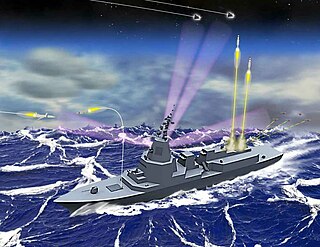
Aegis system equipped vessels (ASEV) or (Japanese: イージス・システム搭載艦) are a proposed pair of ballistic missile defense (BMD) warships to be operated by the Japanese Maritime Self-Defense Force (JMSDF) as dedicated sea-based BMD platforms, serving as an alternative to Japan's now-cancelled land-based Aegis Ashore BMD system.
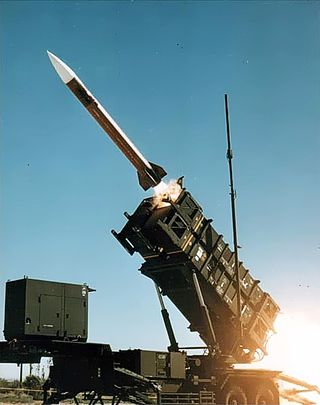
The United States Army Integrated Air and Missile Defense [IAMD] Battle Command System (IBCS) is a plug-and-fight network intended to let a radar or any other defensive sensor feed its data to any available weapon—colloquially, "connect any sensor to any shooter". The IBCS is designed to link radars across thousands of miles and shoot down short-, medium-, and intermediate-range ballistic missiles in their terminal phase.
References
- 1 2 3 Alaska's Long Range Discrimination Radar on Track for 2020 [ dead link ], Jen Judson, DefenseNews.com, 16 August 2016
- ↑ "Long Range Discrimination Radar (LRDR)".
- ↑ Lockheed Martin Demonstrates Next Generation Aegis Ashore Solution Lockheed Martin, Jan 11 2018
- ↑ Department of Defense Identifies Planned Site of Future Long Range Discrimination Radar (LRDR), DoD press release NR-193-15, 22 May 2015, accessed 17 August 2016
- 1 2 C. Todd Lopez, DOD News (7 Dec 2021) Long-Range Discrimination Radar Reshapes Adversaries' Calculus for Attacks Against U.S. Homeland
- ↑ MDA says Alaska-based missile defense radar will be operational in 2021, Jen Judson, DefenseNews, 2021-03-03
- ↑ Missile Defense Agency cancels test of Long-Range Discrimination Radar, Jen Judson, Defense News, 2023-09-02
- ↑ On the result of component selection of the Aegis system (Aegis Ashore) on land deployment(Japanese) Ministry of Defense Japan, 30 July 2018
- ↑ "U.S. Government Designates Lockheed Martin's Latest Generation Radar: AN/SPY-7(V)1 - Nov 14, 2019". Media - Lockheed Martin. Retrieved 2019-12-24.
- ↑ "Lockheed Martin Signs SPY-7 Radar Contract for CSC Frigate". 11 November 2020.
- ↑ Lockheed Martin Advocates Accelerating Aegis, SPY-1 Upgrades USNI.org January 10, 2017
- ↑ "U.S. Navy's SPY-6 Family of Radars". www.raytheonmissilesanddefense.com. Raytheon. 12 July 2020. Retrieved 12 July 2020.
- ↑ Justin Katz Raytheon to start backfitting destroyers with SPY-6 radar. Breaking Defense (11 Jan 2022)